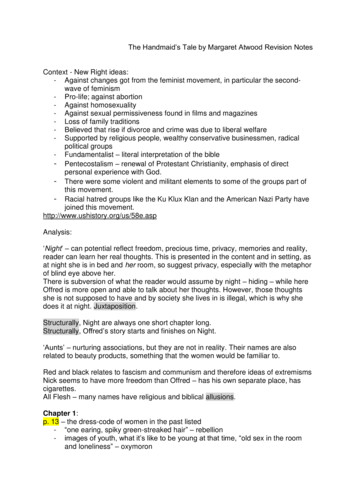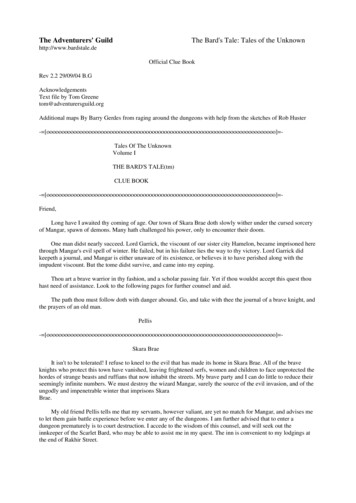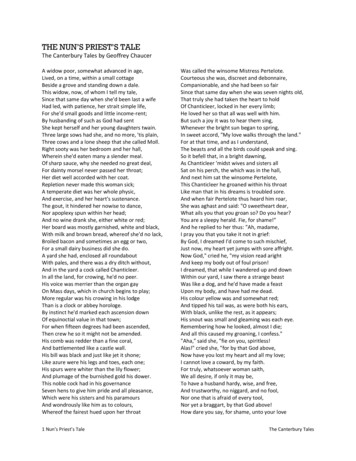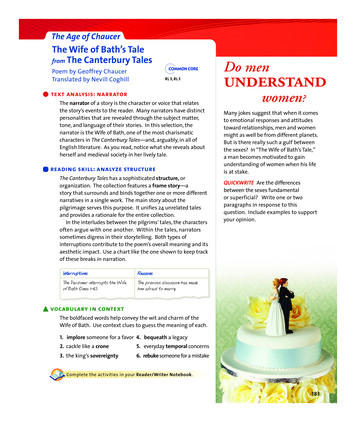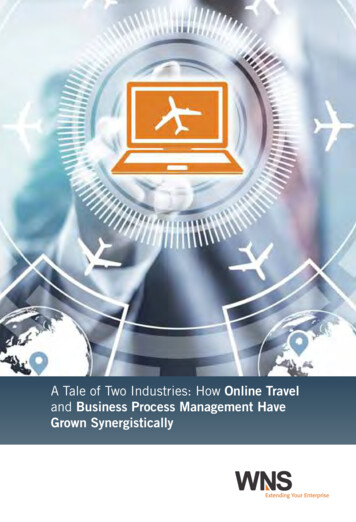
Transcription
A Tale of Two Industries: How Online Traveland Business Process Management HaveGrown SynergisticallyWNSExtending Your Enterprise
WNSExtending Your EnterpriseIntroductionChange has been the only constant for the onlinetravel business. Unrest in tourist hotspots, ahard-hitting recession, mergers and acquisitions,and a complete transformation of consumerbehavioral patterns the industry has seen andsuffered it all.Most Online Travel Agencies (OTA) have leveragedthe expertise of Business Process Management(BPM) partners to stay afloat amidst the changesand challenges. BPM providers have added value01wns.comto the online travel industry and contributedsignificantly to its evolution. As OTAs continueto face sweeping changes in the businesslandscape, the need to have a mature BPMpartner on board is felt more sharply thanever before.This whitepaper traces the history of the OTAindustry and how BPM became an integral partof an OTA's business strategy. The WNS BPMPartner Selection Index, which you will find inthe last section of this paper, will guide OTAstowards identifying the ideal BPM partner fortheir business.
Partners in Growth – OTAand BPMThe Internet heralded the rise of the Online TravelAgency (OTA) in the mid-nineties. The suddenfreedom from prying travel agents, the ease-ofuse options on the OTA website, and convenienceto book tickets, hotel stays and luxury packagesfrom the comfort of one's home, made OTAspopular among consumers. Soon, OTAs became aforce to reckon with in the global travel andleisure industry.The rise of the OTA industry coincided with thegrowth of another industry. The Business ProcessOutsourcing (BPO) industry, now called BusinessProcess Management (BPM), like the onlinetravel industry, challenged conventional businessideas and took the world by surprise. BPO offeredbusiness enterprises the option to run theirback-office and non-core business processes fromcost-effective offshore locations and freeing uporganizations to focus on core activities. Thismodel offered the obvious advantage of costreduction not just because of the labor arbitrage,but other factors such as lower real estate cost.Many businesses jumped on to the BPObandwagon and reaped rich dividends in terms ofcost efficiencies. The OTA industry was one of theearly adopters of the BPO model.The OTA-BPO Relationship That Was: Managingthe Transactional; Focusing on Cost SavingsLike other industries that were early adopters ofBPO, OTAs too, got into the outsourcingbandwagon with cost reduction in mind. In thatera, the engagements were in nascent stages andwere rather tactical and transactional in nature.The offshore partner would manage the OTAcontact center and process transactionaldocuments and data. OTAs engaged with BPOproviders for managing reservations, fulfillingticketing requirements associated with thosereservations, and providing customer service, asshown in fig. 1. This allowed OTAs to focus ontheir core competencies.Air hotelpackagesAt multi-channel points ofsales and fraud tionWebsiteDevelopmentWith suppliers airlines, hotels,car t managementand fare loadingInvoicing- APFulfillmentCommissionCollections- itionsMarketing& PromotionsnnnnnnnSupplierManagementSEO, Google re-marketingPricingPackagingChannel mix - digital, followedby electronic and printWebsite managementChannel developmentChannel analyticsReconciliation-ARC / Billing& SettlementPlanMerchantAccountingRefundsAgency DebitMemos &ChargebacksAPSales, marketing, supply and inventory managementCustomer relationship and customer service managementFinance, accounting, revenue and profit managementFig.1: The typical OTA business cycle. Red circles indicate the circle of influence of a third-party BPO provider on the OTA business in the past.
WNSExtending Your EnterpriseThe OTA industry has met with astoundingsuccess. The industry touched the USD 100Billion mark recently, representing almost onethird of the global e-commerce pie, according toa recent McKinsey report. This success story,however, has had its share of challenges.The OTA model gained popularity after the latenineties, and competition heated up. A number ofplayers emerged, fueling stiff competition on the'best price guarantee'. Competition was not justbetween OTA players. Online agencies also had tocontend with travel providers, particularly thoseairlines that floated their own online agencies orrevamped their Websites to mimic that of anOTA's. Some airlines even withdrew theirinventory from OTA sites. Online Travel Agenciesretaliated by removing listings of some airlinesfrom their sites. The dust appeared to settle onthe conflict by the late 2000s when OTAs werehit by the recession that led to a substantial dipin sales. As the economy recovered, onlineagencies became profitable again. But now theyhad other issues to deal with — tightercompetition, rampant mergers andacquisitions, and the unprecedented growthof digital technology.The OTA-BPO Relationship That Is:Customization of Solutions with Focus onBusiness OutcomesTechnology convergence has completelytransformed customer behavior and expectations.The naïve, easy-to-please customer has suddenlymorphed into someone who is erudite, andhard-to-please.Customers today are more demanding than everbefore, and expect superior experience — be it interms of comprehensive air / cruise / car / hotelbookings / packages or when interacting withtravel domain experts who have a strongunderstanding of the product and destination,and can make valuable suggestions to guidethem. Customers also expect customizedpackages that complement their tastes andchoices, and more importantly, fit their budgets.OTAs, therefore, seek to provide proactiveservices to their customers by trying to gauge03wns.comtheir needs, requirements and expectations. Foran OTA customer, satisfaction is a function ofconvenience, comfort and value for money.This change in the business environment andcustomer behavior has impacted the solutionsdelivered by BPO providers. Along the years, asBPO providers continued to work closely withtheir OTA clients, they gained a deeperunderstanding of their clients' businesses, withthe result that providers developed a flair fordeveloping customized solutions that impactbusiness outcomes for their OTA clients.Today, the scope of services offered by a BPOprovider has widened substantially and solutionsare far more sophisticated than they were inthe past.Seasoned travel outsourcing service providersare delivering the full range of front, mid andback-office processes, in addition to managinglarge parts of the OTA's finance and accountingfunction, through a blend of offshore, nearshoreand onshore delivery model. The straightforwardcontact center has made way for themulti-channel customer interaction center,which providers are managing efficiently withthe implementation of high-end technology.Providers have also graduated to the position ofguardians for training and quality processes,generating further benefits such as wastereduction and providing analytical insights toproduct teams within online agencies. Providersare actively leveraging the power of analyticalmodels to help OTAs segment customers basedon common demographic and psychographicpatterns. Analytics is helping gauge customerbehavior and needs, thus allowing OTAs tocustomize products and services that aptly fit thecustomer's expectations. Providers today arereally 'managing' large parts of the OTA business,as shown in fig. 2.As the industry evolves, OTAs expect outsourcingproviders to deliver much more than cost savingsand infrastructure excellence. Mature providersare at an advantage as their capabilities haveevolved to address their OTA clients' needs.
Air hotelpackagesAt multi-channel points ofsales and fraud tionWebsiteDevelopmentWith suppliers airlines, hotels,car ing- APFulfillmentCommissionCollections- itionsMarketing& PromotionsReconciliation-ARC / Billing& SettlementPlanSupplierManagementContent management& fare loadingMerchantAccountingRefundsAgency DebitMemos &ChargebacksAPSales, marketing, supply and inventory managementCustomer relationship and customer service managementFinance, accounting, revenue and profit managementKey elements of the OTA business cycleFig. 2: The typical OTA business cycle. Red circles indicate the circle of influence of a third-party BPM provider on the OTA business currentlyThese providers are able to provide a diverse mixof process excellence, a readily available globaltalent pool, a global network of delivery centers,technology platforms, and other physicalresources to OTAs. For OTAs, outsourcing is nolonger leveraged just for pure bottom-line impact.It has in fact evolved as an option to create animpact on the top-line as well.Customization of Solutions with Focus onBusiness OutcomesSee how some OTAs have benefitted fromengaging with WNS:nA leading North American Online Travel Agencywas witnessing a dip in its online sales vis-à-viscompetition. WNS worked with the client tointegrate its Customer Interaction Center withits primary Point of Sale (the brand Website) bydeploying proactive 'call' and 'chat'functionalities at potential customer bounce /exit points. This was a smart strategy forcustomer acquisition and customercontainment, and resulted in the increase ofoffline sales by 50 percentnA leading Online Travel Agency saw a markedimprovement in some of its key businessOutsourcing providers have ably supported thegrowth of the OTA industry. Today, providers havegraduated to the level of being known asBusiness Process Management (BPM) partners,impacting business outcomes for OTAs. Some ofthese outcomes are:nReduced cost of ownershipnRevenue enhancementnImproved customer experience and loyaltywns.com04
WNSExtending Your Enterpriseoutcomes with WNS as its BPM partner onboard — its fare filling accuracy levels went upfrom 88 percent to 94 percent and TATcompliance from 90 percent to 99.5 percentnWith WNS as its BPM partner on board, aleading OTA improved its Fraud Caught Ratioand reduced liabilities significantly (7-9percent of total fraud queries). Effective andstringent fraud detection controls led to anexponential decrease of approximately79 percent in fraudulent bookingnWNS enabled a leading European Travel Agencysignificantly increase collections from creditagents by 5 percentnA tour operator improved its paymentprocessing accuracy by 6 percent withWNS's solutionsThe OTA-BPM Relationship That Will Be: CreateHigh Impact on BusinessWhat are the trends shaping the OTA industry andwhere is the OTA-BPM relationship headed fromthis point? We take a look at the trends shapingthe OTA industry.Despite flat growth in the mature U.S. travelmarket, the opportunities are stronger in Europeand Asia, according to research by PhoCusWright.In Europe, the analysts forecast that the onlinetravel market will grow at an average rate of 8percent through 2015. Some of the key trendsthat are shaping the OTA business are:Compressed revenue growth calls for adoption ofnew pricing models: The OTA market is facingchallenging headwinds and the increasinglycritical imperative is to do more with less.Consolidation and price cuts among OTAs havecompressed margins and revenue growth. Thesefactors continue to shape the market, even duringthe global economic recovery. With a global dropin commissions, more and more online travelagencies are adopting new pricing models thatwill help them protect their revenues.05wns.comRealignment of traditional business: There hasbeen a widespread emergence of value-addedservices such as promotions and corporatepackages to attract customers and gather a largemarket share. OTAs are following a hybrid modelconstituting online and offline stores to penetratethe market even further. OTAs are focusing moreon the high margin package and hotel businesswhile alternative accommodations (villas andvacation homes) are evolving as a substantial newgrowth category for OTAs.Reduced spends: Reduced spending and thepressure to cut costs is probably the mostimportant challenge for the majority of travelagencies globally. Some of the major initiativesundertaken by such companies include closure ofbrick-and-mortar agency branches, reducingvarious overhead expenses, controlling goodwillgestures to customers, and restricted spends onmarketing and promotions.Focus on newer / growth markets and localizedbusiness models: For the OTA industry, thebiggest opportunity currently is in the AsiaPacific (APAC) belt. There are a billion MiddleClass passengers waiting to discover the world.Cultures in the APAC region are way too diverseand so are customer choices and preferences. Totap the potential of this part of the world, OTAsare moving toward a 'glocal' strategy – goingglobal while retaining a 'local' flavor of business.Intensifying competition: The top OTAs, onceviewed as market-transforming innovators, arenow are facing intense competitive pressure fromnew entrants who focus on fewer products,possess the latest technology, leverage the omnichannel model for customer engagement, and useapproaches like keyword purchase to attractdesired traffic.The disruption called 'convergence': At a timewhen OTAs face growing global competition and ashrinking workforce, one disruptive keyword rulesall: 'convergence'. Indeed, convergence is driving
a lot of action in the online travel market. Theconvergence is being driven in many ways:qDevices – Customers are now accessingservices from smartphones, tablets, laptopsand what have youqLoyalty points and real money – Hotel chainsare allowing mixing loyalty points and cashwhile flashing tariffs to customersqPre-travel research and actual booking – Metasearch engines
Most Online Travel Agencies (OTA) have leveraged the expertise of Business Process Management (BPM) partners to stay afloat amidst the changes and challenges. BPM providers have added value to the online travel industry and contributed significantly to its evolution. As OTAs continue to face sweeping changes in the business



